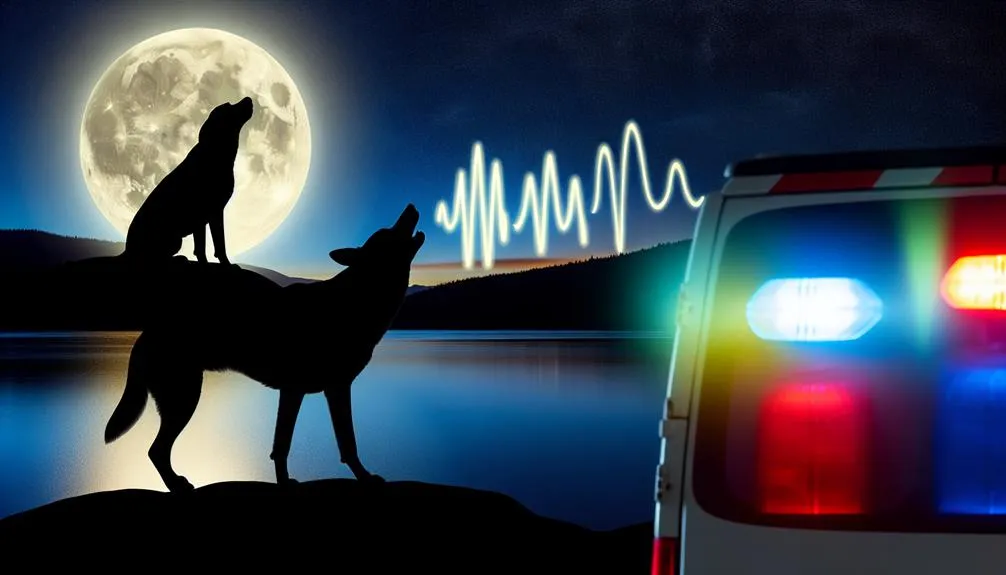
Why Do Dogs Howl at Sirens
Imagine you're walking your dog when an ambulance siren blares nearby, and your pet suddenly erupts into a howling symphony. You might wonder why this instinctual response occurs. It's not just a quirky behavior; it ties back to their evolutionary past and communication methods. Understanding the reasons behind this phenomenon could reveal much about your dog's emotions and instincts. What exactly triggers this reaction, and how can it affect their behavior in other situations?
Canine Communication Methods
Dogs have a unique way of communicating, and howling is just one of the many methods they use to express themselves. When you observe your dog, you'll notice that their communication isn't limited to vocalizations alone. Body language plays an important role in how they convey their feelings and intentions. For instance, a wagging tail can indicate excitement, while a lowered body posture may signal submission or fear.
Vocalizations, including barking, whining, and howling, serve different purposes. Each sound carries a specific meaning, and dogs often combine these vocalizations with body language to enhance their message. For example, a dog that barks excitedly while jumping may be trying to alert you to a perceived threat or simply express joy. Conversely, a dog that howls might be responding to a siren, feeling a connection to their ancestors or attempting to communicate with other dogs in the vicinity.
You might also notice how your dog reacts to different stimuli, such as the sound of a doorbell or the arrival of visitors. Their varied vocalizations, alongside their body language, help you understand their emotional state and intentions. By paying close attention to these cues, you can foster a deeper bond with your dog and respond appropriately to their needs. Understanding canine communication methods enriches your relationship, allowing you to interpret their feelings and react in a way that reassures and comforts them.
The Howling Instinct
Howling is a behavior rooted deeply in a dog's instinctual past, often serving as a form of long-distance communication. This vocalization isn't just a random occurrence; it's a complex response that can be triggered by various stimuli, including sirens. When you hear your dog howling in response to a siren, it's not merely mimicking the sound; it's tapping into an ancient instinct to communicate with its pack.
In the wild, howling serves multiple purposes, such as locating lost members, signaling danger, or coordinating group activities. The howling triggers in domestic dogs can vary; sometimes it's a response to high-pitched noises or sounds that resemble the calls of other canines. You might notice that your dog's howling has distinct vocalization patterns, which can differ based on the situation or even the individual dog's personality.
Understanding these patterns can provide insight into your dog's emotional state. For instance, a long, mournful howl might indicate distress or loneliness, while a series of sharp howls could suggest excitement or alertness. By recognizing these vocalization patterns, you can better interpret your dog's feelings and needs.
Ultimately, howling connects dogs to their ancestors, allowing them to express themselves in ways that resonate with their instinctual heritage. So, the next time your dog howls at a siren, remember, it's not just noise; it's a bridge to a primal way of communicating that's still alive in our modern companions.
Sensitivity to High Frequencies

Many pet owners may not realize that dogs possess a heightened sensitivity to high frequencies compared to humans. This enhanced auditory perception is a vital aspect of Canine behavior, particularly when it comes to howling at sirens. You might wonder why this is the case, so let's break it down:
- Anatomy of the Ear: Dogs have more sensitive inner ear structures, which allow them to detect sounds at much higher frequencies.
- Frequency Sensitivity: While humans hear sounds up to about 20 kHz, dogs can hear frequencies as high as 65 kHz, making their auditory domain far more expansive.
- Natural Instincts: This heightened sensitivity is likely a survival trait, allowing dogs to detect the sounds of prey or danger that are inaudible to humans.
- Vocal Communication: Howling may serve as a form of communication, helping dogs to signal their presence or express distress in response to high-pitched sounds like sirens.
When a siren wails, it produces sounds that fall within the higher frequency range. To your dog, this might feel like a call to action, triggering an instinctive response. They might not just hear the sound; they seem to feel it, compelling them to join in with a howl. This behavior is a fascinating illustration of canine frequency sensitivity and how it shapes their interactions with the world around them. Understanding this can deepen your appreciation for your furry friend's unique perceptions.
Social Bonding and Pack Behavior
When a siren pierces the air, it can trigger not just an instinctive response in dogs but also a profound connection to their social structure and pack behavior. You might notice your dog howling in response, and this vocalization serves multiple purposes within their social hierarchy. Dogs are inherently social creatures, and howling can be a way of reinforcing group dynamics among pack members.
Through vocal interactions, dogs communicate their feelings and intentions, fostering a sense of unity. When one dog howls, others often join in, creating a chorus that strengthens their bonds and signifies cooperative behaviors. This collective response can be viewed as a bonding ritual, where the act of howling reinforces their relationships and enhances group cohesion.
Moreover, howling can serve as a form of territorial signaling. By responding to sirens, dogs may be asserting their presence and marking their territory within their environment. This behavior not only reflects their instinctual nature but also highlights the importance of social connections.
As you observe your dog, consider how these vocalizations contribute to their understanding of social roles. Each howl might resonate with others in the vicinity, creating an interplay of communication that transcends mere instinct. In this way, howling at sirens is more than just an echo; it's a rich tapestry of social bonding, where dogs engage in shared experiences that foster their pack mentality.
The Role of Ancestry

When you think about why dogs howl at sirens, it helps to contemplate their ancestry and the communication methods of their wild relatives. These primitive instincts are still present, reflecting a deep-rooted pack behavior that once served vital survival purposes. By examining these ancestral traits, you can better understand the significance of howling in today's domestic dogs.
Canine Ancestry and Communication
Dogs' howling at sirens can be traced back to their ancestry, revealing a fascinating connection between their wild roots and modern communication. Understanding this behavior involves delving into several key factors:
- Dog Ancestry: Dogs share common ancestors with wolves, who used vocalizations to communicate over long distances.
- Vocalizations Evolution: Over time, dogs adapted their vocalizations, shaping the way they interact with their environment and humans.
- Sound Perception: Dogs have heightened sound perception, allowing them to detect frequencies that are imperceptible to us, which may trigger their howling.
- Genetic Predispositions: Certain breeds exhibit stronger tendencies for vocalizations, reflecting ancestral traits that influence their behavior.
These elements highlight how dogs' instinctual behavior is rooted in their genetic history. Their auditory responses to sounds like sirens may be an echo of their wild ancestors' communication origins. By studying these connections, you can appreciate how deep-seated instincts shape your dog's behavior today. This understanding not only enriches your bond with your pet but also sheds light on the evolutionary journey that connects dogs with their wild counterparts.
Primitive Instincts in Action
Howling at sirens serves as a tangible illustration of primitive instincts in action, reflecting the deep-rooted behaviors inherited from dogs' wild ancestors. When your dog howls at a siren, it's not just a quirky behavior; it's an ancestral echo of communication methods used by wolves. These howling triggers can evoke a sense of connection, reminding canines of their pack's calls in the wild.
Understanding this instinct can be enhanced by considering the following table:
| Aspect | Description |
|---|---|
| Ancestral Behavior | Howling served to communicate location and alert others. |
| Modern Trigger | Sirens mimic sounds that can initiate a howl response. |
| Emotional Response | Dogs may feel compelled to respond to perceived "calls." |
As you observe your dog's reaction to sirens, consider how these sounds resonate within them. It's fascinating to see how these primitive instincts still play a significant role in their behavior, connecting them to a time when survival depended on effective communication and social cohesion. This instinctual response is a powerful reminder of their wild heritage.
Pack Behavior and Howling
The connection between pack behavior and howling is deeply rooted in a dog's ancestry, showcasing how these social animals communicate within their groups. Understanding this relationship can help you appreciate why your dog might join in when sirens wail. Here are some key points about pack dynamics and vocal signals:
- Communication: Howling serves as a way for dogs to communicate their location to other pack members, establishing a sense of togetherness.
- Hierarchy: Vocal signals, like howling, can indicate a dog's place within the pack, showing submission or dominance.
- Bonding: When a dog howls, it strengthens social ties among pack members, reinforcing group cohesion.
- Instinctual Behavior: Many canines howl in response to certain sounds (like sirens) due to instinctual urges inherited from their ancestors.
In essence, when your dog howls at sirens, it's not just a random act; it's a manifestation of deep-seated pack dynamics and ancestral communication methods. This behavior reflects their natural instincts to bond and establish connections within their social structure, reminding you of their wild heritage.
Emotional Responses to Sounds
When exposed to certain sounds, many dogs exhibit emotional responses that can be quite fascinating. You might notice your dog howling at sirens, which can be attributed to their heightened sound perception. Dogs hear a broader range of frequencies than humans do, so a siren's wail can trigger strong emotional reactions. These responses often stem from instinctual behaviors, as the sound can mimic the calls of their wild ancestors.
You might be surprised to learn that various sounds can evoke different emotional triggers. For example, high-pitched noises like sirens may sound alarming or distressing to your dog, prompting them to howl as a form of communication or to express their Anxiety. In contrast, some dogs may react joyfully to sounds associated with play, like squeaky toys or their owner's voice.
Your dog's emotional responses to sounds are influenced by their past experiences and socialization. If they've had positive interactions related to specific sounds, they may respond with excitement rather than Anxiety. Conversely, if a loud noise startled them in the past, they might howl or bark in fear when they hear similar sounds again.
Tips for Managing Howling

For many dog owners, managing their pet's howling can feel like an intimidating task, especially during noisy moments like passing sirens. However, with the right strategies, you can implement effective howling management. Here are a few tips to help you tackle this behavior:
- Identify Triggers: Observe when your dog howls. Is it only during sirens, or are there other sounds involved? Understanding the triggers can guide your response.
- Desensitization: Gradually expose your dog to the sounds that provoke howling. Start with recordings at a low volume and increase it slowly over time, rewarding calm behavior.
- Positive Reinforcement: Use training techniques that reward your dog for being quiet. When they remain silent during a siren, give treats or praise to reinforce that behavior.
- Provide Distractions: Engaging your dog with toys or interactive games can divert their attention away from the triggering sounds, reducing the urge to howl.
Frequently Asked Questions
Do All Dog Breeds Howl at Sirens?
Not all dog breeds howl at sirens, but many exhibit varying siren responses. This behavior often stems from their ancestral instincts, which can differ considerably based on individual dog breed behavior and genetic predispositions.
Can Howling Be a Sign of Distress?
You might think howling's just a dramatic performance, but it can signal distress. When howling triggers emotional responses, it's often a dog's way of expressing Anxiety or discomfort, revealing their deeper feelings you might not notice.
How Can I Tell if My Dog Is Howling at Sirens?
You can tell if your dog's howling triggers are related to sirens by observing their body language and vocalizations. Canine communication often reveals excitement or distress, so watch for changes in their behavior during those moments.
Is Howling Contagious Among Dogs?
Yes, howling can be contagious among dogs. It's a form of howling communication, reflecting their social behavior. When one dog howls, others may join in, creating a harmonious chorus that strengthens their Social bonds.
What Should I Do if My Dog Howls Excessively?
If your dog's howling is excessive, try calming techniques like soothing music or a comfortable space. Observe their triggers and gradually desensitize them, ensuring a peaceful environment to help reduce their howling behavior over time.
Conclusion
So, the next time your dog serenades the neighborhood with their howls at a passing siren, just remember—it's not a solo album drop, but rather an ancestral call to their long-lost pack members. While you might see a canine diva in action, they're simply echoing their wild roots and steering through their social landscape. Who knew that a mere siren could release a modern-day wolf's opera? With a little understanding, you can appreciate their unique voice instead of wishing for a mute button.
You may also like
Archives
Calendar
| M | T | W | T | F | S | S |
|---|---|---|---|---|---|---|
| 1 | 2 | 3 | 4 | 5 | 6 | |
| 7 | 8 | 9 | 10 | 11 | 12 | 13 |
| 14 | 15 | 16 | 17 | 18 | 19 | 20 |
| 21 | 22 | 23 | 24 | 25 | 26 | 27 |
| 28 | 29 | 30 | ||||
Leave a Reply